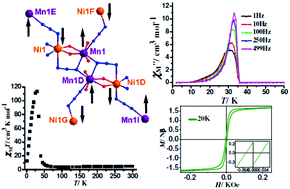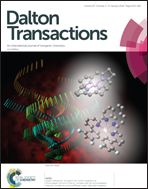A nickel(ii)–manganese(ii)-azido layered coordination polymer showing a three-dimensional ferrimagnetic order at 35 K†
Abstract
The work in this report describes the synthesis, characterization, crystal structure and magnetic properties of a two-dimensional azido-bridged NiIIMnII heterometallic coordination polymer, [{(NiIILMnII)2(μ1,1,3-N3)2}(μ1,3-N3)2]n (1), in which the H2L Schiff base is the [2 + 1] condensation product of 3-methoxysalicylaldehyde and 1,3-diaminopropane. In 1, two bis(μ-phenoxo)-μ1,1,3-azido-NiIIMnII dinuclear units are interlinked to form a dimer-of-dinuclear moiety {NiIIMnII}2; the {NiIIMnII}2 structural units are further interlinked with each other by μ1,3-azido ligands to form a layered coordination polymer. Upon cooling, the χMT product slowly decreases from 300 K to about 100 K, then increases abruptly from 3.74 cm3 K mol−1 at 100 K to 113.2 cm3 K mol−1 at 30 K, indicating a ferrimagnetic behaviour; a three-dimensional magnetic order below 37 K was determined by the divergence in the ZFC-FC measurements and ac measurements, in which the peak temperature 35 K in the in-phase at different frequencies suggests that the Curie temperature is 35 K, whereas the out-of-phase is somewhat frequency dependent, due to the glassy magnet behaviour. The title compound is among the rare examples of metallo-organic systems having a magnetic ordering Curie temperature above 30 K. Other interesting aspects in 1 regarding magnetic properties and structural features are discussed.



 Please wait while we load your content...
Please wait while we load your content...